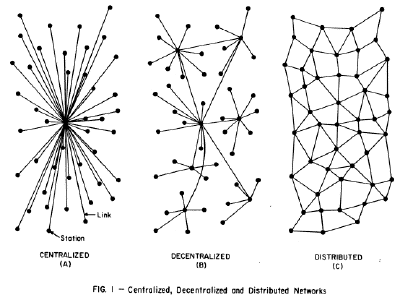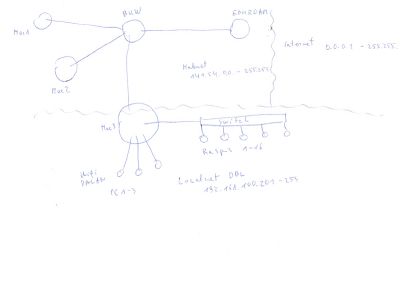Networks
Physically, computer networks are connected to each other non-hierarchically and do not necessarily depend on intermediaries, e.g. servers routing digital information to the end computer.
Nevertheless, computers within the computer networks are usually connected over the network switch or wireless router, in such a way forming a decentralized (and at the same time semi-hierarchical; see Fig.1.) network. In order for the computers to interact with each other, the networks are based on certain rules set across the different protocols. The Internet Protocol Suite (TCP/IP) is one of the most widely used set of protocols forming a network of interconnected computers. One of its abstraction layers, the Internet Layer, facilitates the interconnection of networks, enabling digital data flow among computers. Its Internet Protocol (IP) defines the fundamental address spaces that are then controlled by Domain Name Servers (DNS). In other words, the Internet is defined by TCP/IP and DNS (Braden 1989).
Being the most prevailing, the Internet is also seen as a layer for other networks that can be constructed in order to permit the routing of digital data in predefined lower level networks. For example, the Local Area Network (LAN) is usually used for small-scale networks and is defined by physical space, like a room or house. A Wide Area Network (WAN) or Virtual Private Network (VPN) can overarch a much broader geographical area but are still used in a defined network by businesses or governments. Those networks are usually constructed upon hierarchical routing rules using intermediary servers, and self-organization within those networks could only be possible with a set of predefined exceptions, such as elements a, b, and c, which may become self-organized if all of them are connected to an element d (see for example entry at wikipedia for dhcp).
In contrast to the network systems mentioned above, other network concepts are based on Peer-to-Peer (P2P) or computer-to-computer connections, which may have a decentralized or distributed character better suited to self-organized systems. However, as was mentioned earlier, they would still be dependent on the Internet layer organized upon a semi-hierarchical DNS system, which is controlled by the Internet Corporation for Assigned Names and Numbers (ICANN). This corporation is responsible for managing all IP addresses, and it therefore makes the Internet centralized from the perspective of IP addresses provided.
DBL networks
Showcase
Tutorials
https://www.uni-weimar.de/kunst-und-gestaltung/wiki/GMU:Tutorials
Hardware
- Linux, Mac
- Sound system
- Video wall
- video tracking system
Software
- Unity 3d, Unreal Engine
- captury
- Zirkonium
- Pure data, Max
- Processing
- mobmuplat, touchOSC

